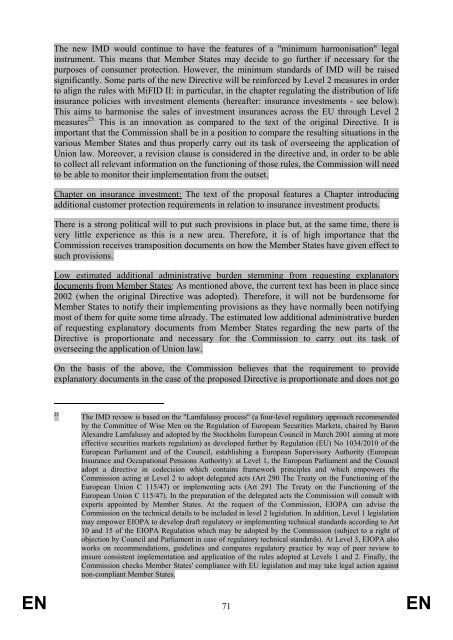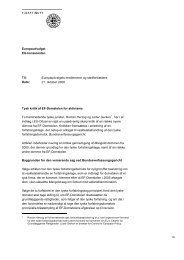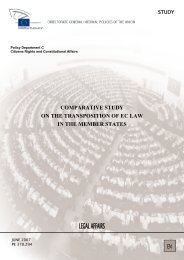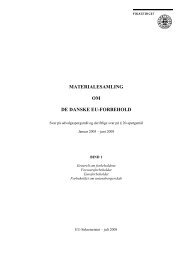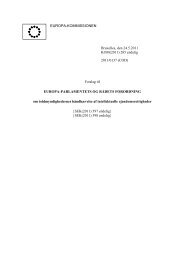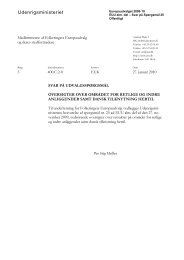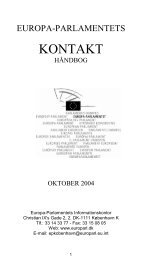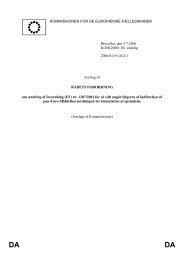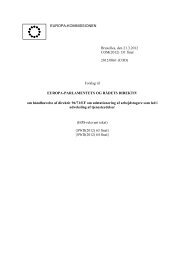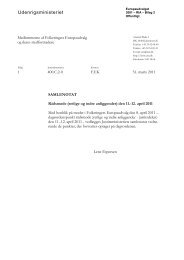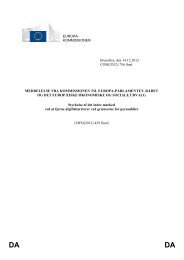EUROPEAN COMMISSION Brussels, XXX COM(2012) 360 ... - BVVM
EUROPEAN COMMISSION Brussels, XXX COM(2012) 360 ... - BVVM
EUROPEAN COMMISSION Brussels, XXX COM(2012) 360 ... - BVVM
Create successful ePaper yourself
Turn your PDF publications into a flip-book with our unique Google optimized e-Paper software.
The new IMD would continue to have the features of a "minimum harmonisation" legal<br />
instrument. This means that Member States may decide to go further if necessary for the<br />
purposes of consumer protection. However, the minimum standards of IMD will be raised<br />
significantly. Some parts of the new Directive will be reinforced by Level 2 measures in order<br />
to align the rules with MiFID II: in particular, in the chapter regulating the distribution of life<br />
insurance policies with investment elements (hereafter: insurance investments - see below).<br />
This aims to harmonise the sales of investment insurances across the EU through Level 2<br />
measures 25. This is an innovation as compared to the text of the original Directive. It is<br />
important that the Commission shall be in a position to compare the resulting situations in the<br />
various Member States and thus properly carry out its task of overseeing the application of<br />
Union law. Moreover, a revision clause is considered in the directive and, in order to be able<br />
to collect all relevant information on the functioning of those rules, the Commission will need<br />
to be able to monitor their implementation from the outset.<br />
Chapter on insurance investment: The text of the proposal features a Chapter introducing<br />
additional customer protection requirements in relation to insurance investment products.<br />
There is a strong political will to put such provisions in place but, at the same time, there is<br />
very little experience as this is a new area. Therefore, it is of high importance that the<br />
Commission receives transposition documents on how the Member States have given effect to<br />
such provisions.<br />
Low estimated additional administrative burden stemming from requesting explanatory<br />
documents from Member States: As mentioned above, the current text has been in place since<br />
2002 (when the original Directive was adopted). Therefore, it will not be burdensome for<br />
Member States to notify their implementing provisions as they have normally been notifying<br />
most of them for quite some time already. The estimated low additional administrative burden<br />
of requesting explanatory documents from Member States regarding the new parts of the<br />
Directive is proportionate and necessary for the Commission to carry out its task of<br />
overseeing the application of Union law.<br />
On the basis of the above, the Commission believes that the requirement to provide<br />
explanatory documents in the case of the proposed Directive is proportionate and does not go<br />
25 The IMD review is based on the "Lamfalussy process" (a four-level regulatory approach recommended<br />
by the Committee of Wise Men on the Regulation of European Securities Markets, chaired by Baron<br />
Alexandre Lamfalussy and adopted by the Stockholm European Council in March 2001 aiming at more<br />
effective securities markets regulation) as developed further by Regulation (EU) No 1034/2010 of the<br />
European Parliament and of the Council, establishing a European Supervisory Authority (European<br />
Insurance and Occupational Pensions Authority): at Level 1, the European Parliament and the Council<br />
adopt a directive in codecision which contains framework principles and which empowers the<br />
Commission acting at Level 2 to adopt delegated acts (Art 290 The Treaty on the Functioning of the<br />
European Union C 115/47) or implementing acts (Art 291 The Treaty on the Functioning of the<br />
European Union C 115/47). In the preparation of the delegated acts the Commission will consult with<br />
experts appointed by Member States. At the request of the Commission, EIOPA can advise the<br />
Commission on the technical details to be included in level 2 legislation. In addition, Level 1 legislation<br />
may empower EIOPA to develop draft regulatory or implementing technical standards according to Art<br />
10 and 15 of the EIOPA Regulation which may be adopted by the Commission (subject to a right of<br />
objection by Council and Parliament in case of regulatory technical standards). At Level 3, EIOPA also<br />
works on recommendations, guidelines and compares regulatory practice by way of peer review to<br />
ensure consistent implementation and application of the rules adopted at Levels 1 and 2. Finally, the<br />
Commission checks Member States' compliance with EU legislation and may take legal action against<br />
non-compliant Member States.<br />
EN 71 EN


